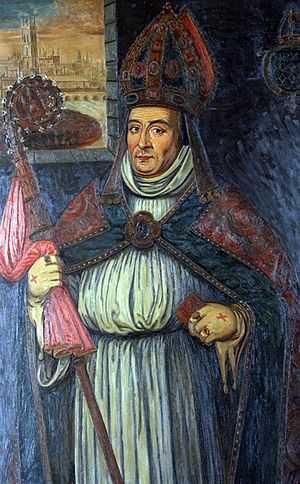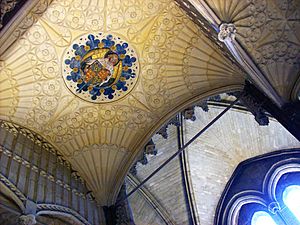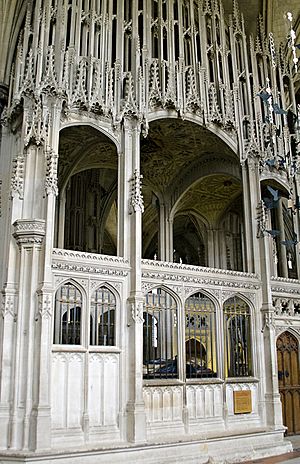William Waynflete facts for kids
Quick facts for kids William Waynflete |
|
|---|---|
| Bishop of Winchester | |
 |
|
| Church | Roman Catholic |
| Appointed | 10 May 1447 |
| Reign ended | 11 August 1486 |
| Predecessor | Henry Beaufort |
| Successor | Peter Courtenay |
| Orders | |
| Ordination | 21 January 1426 |
| Consecration | 30 July 1447 by John Stafford |
| Personal details | |
| Born | c. 1398 Wainfleet, Lincolnshire, England |
| Died | 11 August 1486 Bishop's Waltham, Hampshire, England |
William Waynflete (born around 1398, died August 11, 1486) was an important English leader. His birth name was William Patten. He served as the head of Eton College from 1442 to 1447. Later, he became the Bishop of Winchester (1447–1486) and even the Lord Chancellor of England (1456–1460).
Waynflete is most famous for starting Magdalen College, Oxford. He also founded three schools connected to it: Magdalen College School in Oxford, Magdalen College School, Brackley in Northamptonshire, and another in his hometown of Wainfleet All Saints in Lincolnshire.
Contents
Early Life and Education
William Waynflete was born in a town called Wainfleet in Lincolnshire, which is how he got his last name. This was around the year 1398. His father, Richard Patten, was a merchant. William also had a younger brother, John, who later became a dean at Chichester.
It is believed that Waynflete studied at the University of Oxford. He likely attended one of the grammar schools there before moving on to higher studies. A letter from the university's leader, the Chancellor, called Oxford his "mother" who helped him gain knowledge. This shows how important his education was.
Waynflete became a priest on January 21, 1426. He was connected to Spalding Priory at that time.
Starting His Career

In 1429, Waynflete became the headmaster of Winchester College. He held this job until 1441. During this time, he also became the master of St Mary Magdalen's Hospital. This was a hospital for people with leprosy near Winchester.
In 1441, King Henry VI visited Winchester College. He was very impressed with Waynflete. By the end of that year, Waynflete was no longer the headmaster. In 1442, he became the Provost (head) of Eton College.
Eton College and Its Beginnings
King Henry VI founded Eton College on October 11, 1440. He wanted it to be like Winchester College. Eton was meant to have a provost, priests, singers, and 25 poor scholars. It also had a "headmaster" to teach grammar for free to anyone who came.
Waynflete was the first Provost of Eton. Even though he was called the first headmaster, the school building didn't start until May 1442. His main job as Provost was to manage the money and finish the college buildings. He helped increase the number of scholars at Eton. By 1446–1447, Eton had its full number of 70 scholars.
Becoming Bishop of Winchester
Waynflete became very close to King Henry VI. When Henry Beaufort, the Bishop of Winchester and the king's uncle, died in 1447, the king asked the church leaders to choose Waynflete as the new bishop. Waynflete was officially chosen on May 10, 1447. He was consecrated (made a bishop) on July 13, 1447, in Eton church.
As bishop, Waynflete decided to follow the example of other important leaders and start his own college. On May 6, 1448, he got permission to found a new school in Oxford. He named it Seint Marie Maudeleyn Halle. It was for studying religious ideas and philosophy. The name "St Mary Magdalen" came from the hospital in Winchester that Waynflete used to lead.
On January 19, 1449, Waynflete was officially welcomed as Bishop in Winchester Cathedral. King Henry VI was there and often visited the college chapel.
Dealing with Challenges
Jack Cade's rebellion happened in 1450. Waynflete helped the Archbishop of Canterbury talk with the rebels. They promised a full pardon. Later, Waynflete was one of the people who tried the rebels.
In 1453, Prince Edward was born. Waynflete baptized him. The king became ill in 1454. Waynflete was part of a group sent to ask the king to name a new Chancellor.
Waynflete wanted a bigger space for his college. In 1456, he got permission to use the Hospital of St John the Baptist in Oxford. He officially founded a new college there on June 12, 1458. This new college, called the New College of St Mary Magdalen, took over Magdalen Hall.
Serving as Lord Chancellor
Waynflete was given a very important job: Lord Chancellor. He received the official seals for this role on October 11, 1456. This meant he was a top advisor to the king and oversaw many government duties.
In 1457, he was involved in the trial of Reginald Pecock, who was the Bishop of Chichester. Pecock was accused of heresy (beliefs against church teachings). Waynflete also added rules to the Eton College laws, making sure teachers and students promised not to follow certain heresies.
Waynflete was the Chancellor during a special parliament in 1459. This parliament punished leaders who supported the Duke of York after they lost a battle. Because of this, Waynflete gave up his role as Lord Chancellor on July 7, 1460, just before a battle at Northampton.
Later Life and Legacy

Waynflete remained loyal to King Henry VI. Even when the Yorkist side took power, Waynflete was not seen as an enemy. He continued to work for the good of his church and colleges.
Helping Eton College
Waynflete played a big part in bringing Eton College back to its full strength. King Edward IV had taken away some of Eton's property in 1463. Waynflete worked to get these back. From 1471 to 1474, he was very busy finishing the church (now called the chapel) at Eton. He made sure the windows were installed and helped build the special screen inside the chapel. In 1479, he built the front part of the chapel.
Building Magdalen College
In 1474, Waynflete helped make sure money from a will was used for Magdalen College. The new buildings for Magdalen College began that same year. The first stone was laid on May 5, 1474.
By 1480, the college was finished. New rules were made for the college. It was set up for a head and 70 scholars. These scholars were divided into 40 fellows and 30 "demies," who received half the food allowance of the fellows.
Magdalen College School
Waynflete also started Magdalen College School right next to the college. Like Eton, it was a grammar school where students could learn for free. It had a master and an assistant. Students were encouraged to study classical literature.
In 1481, Waynflete welcomed King Edward IV to the college. In 1483, he hosted King Richard III there.
In 1484, Waynflete founded another Magdalen College School in his hometown of Wainfleet All Saints, Lincolnshire. This school was meant to prepare students for Magdalen College, Oxford. Today, the building is used as a library and museum.
William Waynflete died on August 11, 1486, at Bishop's Waltham in Hampshire. He was buried in the Magdalen Chapel at Winchester Cathedral.
Remembering William Waynflete
Many things are named after William Waynflete to remember his important work:
- The Waynflete Building at Magdalen College, Oxford is a place where students live.
- The college also supports special science professors called the Waynflete Professorships.
- There is a Waynflete School in Portland, Maine, USA.
- Roads and streets are named after him in Oxford, Winchester, Bishop's Waltham, and London.
- "Waynflete" is a boarding house for boys at Eton College.
- An annual service, called the Waynflete Obit, is held in Winchester Cathedral on the day he died. A choir called the Waynflete Singers performs there.
- At Magdalen College School, Oxford, older students do research projects called Waynflete projects.
See also
- Wayneflete Tower


